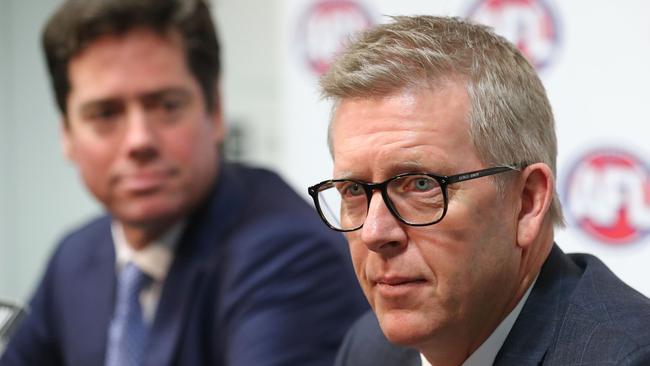Why Steve Hocking must be careful as he considers sweeping rule changes for AFL season 2019
THE controversy over a correctly awarded free kick to Geelong’s Patrick Dangerfield for a ruck infringement highlights the flow-on effects that can - and will - happen with rule changes in the AFL.

- Bone’s Team of the Week: Big guns fire
- The Phantom’s Round 18 SuperCoach review
- Blight: Can young Crows star cap rapid rise?
- The run home: Crows a finals wildcard
“CHANGE the ruck rule back to what it was!”
“Players shouldn’t have to nominate, it’s not under-10s.”
“Umpiring decisions have cost Melbourne four points.”
That was the chorus of discussion in the aftermath of one of the games of the year on Saturday. A match where Geelong clawed back a 29-point deficit in the last quarter to snatch an unlikely victory with a Zach Tuohy goal after the siren.
Yet the biggest talking point is an umpiring decision (from the second quarter) involving Patrick Dangerfield nominating for the ruck.
Let’s start with the rule change: Outlawing the third man up in a ruck contest which came into play at the start of the 2017 season. Many would say that came on the back of a surge in use of the tactic by the Bulldogs in their premiership year of 2016.
The argument was that the ruck craft is one of the unique elements of our game and by banning the third man up, which was often used to nullify the best ruckman, that this would preserve the position and discourage teams from playing athletic midfielders as ruckman and sending a third man up at most of the contests around the ground.
Has it been a success? If you measure the influence of ruckman in games this year I would say “yes”. Max Gawn is among the Brownlow favourites, Brodie Grundy has been outstanding. Nic Naitanui (until injured), Stef Martin, Ben McEvoy and Paddy Ryder have all played major roles at their clubs.
But it would be very much a qualified “yes”. Because it has come at a cost: The cost being confusion.
When the rule was changed I’m sure everyone assumed that we all knew who the ruckman were and we just penalise the third person if, and when, they jump in the ruck contest. Simple, right?

Wrong. There is an existing rule that says you can’t block the ruckman from jumping at the ball in the ruck contest, and with some teams only playing one ruckman, when he was resting it was often unclear who the ruckman was.
Coaches then started using this as a tactic to get a free kick and hence the need for the umpire to get players to nominate for the ruck contest.
I’ve heard people say, “yeah, but we all know who the ruckman is”. Well, on the weekend there was Shaun Grigg, Ollie Wines, Brad Ebert, Hugh Greenwood and Callan Ward who all took ruck contests. The umpires, quite rightly for the sake of clarity for all the players, go through the ritual of having players nominate for each and every ruck contest.
Just for the record, Dangerfield nominated for the ruck, the umpire told the players twice that he had nominated and paid the free kick when he was impeded by young Demon Angus Brayshaw who clearly was oblivious to the situation.
This is why the AFL has to be so careful in regards to the changing of any rules. If we use this as an example, the protection of the ruck craft is a big tick but we have created a new problem around having to nominate. What is the point of eliminating one problem if we are just creating another?
Clubs are already talking about how to approach the new rules regarding starting points and zones and, if they were to be introduced next year, I guarantee they will have thought of ways of exploiting them before the first ball of 2019 is bounced.
I am not totally against change and there is merit in a lot of the proposals being put forward by Steve Hocking and his team at the AFL. I just want there to be more rigour around the decisions. Internal trials for 20 minutes at training just doesn’t cut it.
The AFL needs to convince the NEAFL, VFL, SANFL or somebody, to use the proposed rule changes for a season to gauge the results and impact.
The last possession out of bounds rule in the SANFL is a great example. The data gained from having it in practice shows how many infringements per match, the reduction in stoppages, the effects on scoring, as well as feedback from coaches and players. The risk of implementing that rule would appear much lower than many others that have been suggested and remain untried.
The common ground for most of us is that we want an entertaining product that bears some semblance to what we know as our great game of football. And while I’m happy that some changes have improved the game many have eroded the fabric and spirit of the things we loved about it.
I would rather wait a year or even two and get the changes right, then rush into it and move our game further away from where we all want it to be.
